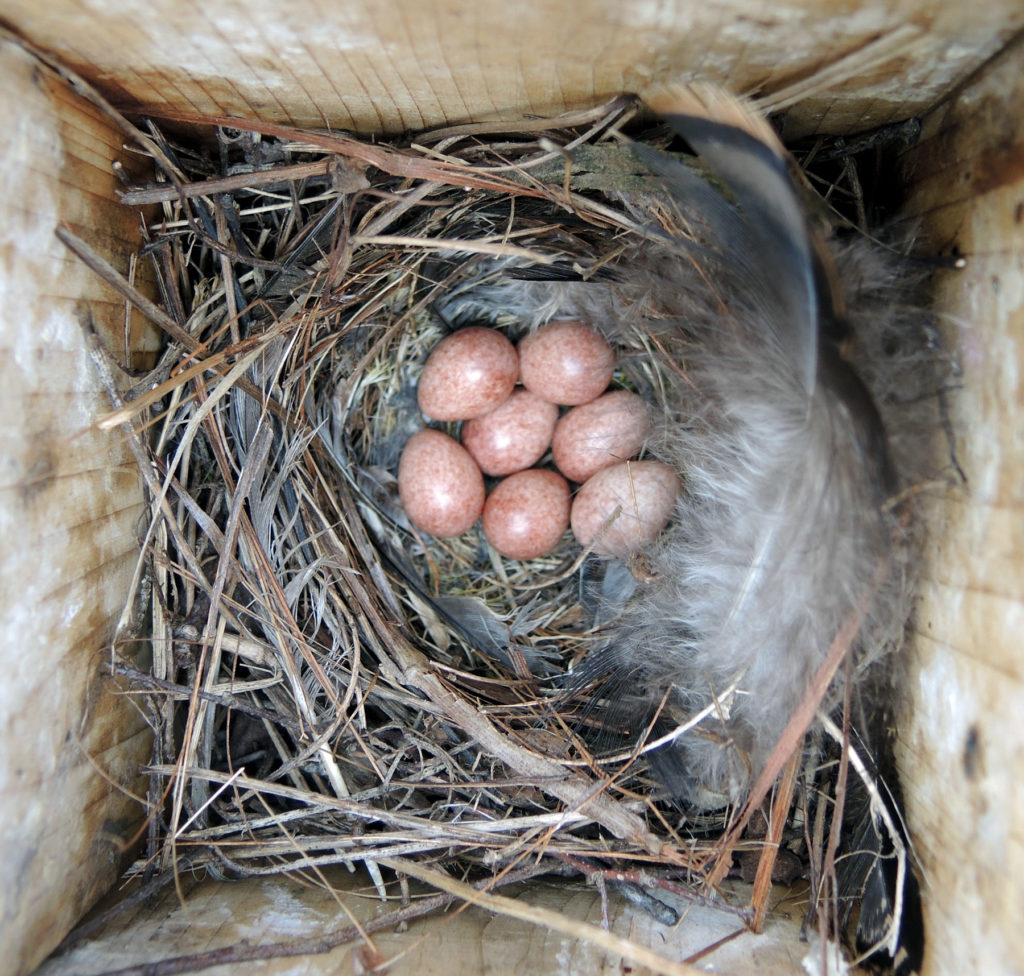Door to Nature: Jenny Wren and Her Relatives
- Share
- Tweet
- Pin
- Share

Every few years a bird that is a common nester in the south shows up at a suet feeder in Door County in the dead of winter. It is the Carolina Wren. One early report came from a resident north of Ellison Bay dating back to December 1972.
Only four of the nine wren species that nest in the continental United States are Door County nesters: the Winter, Marsh, Sedge and House. A Carolina Wren was reported on Washington Island in April of this year and was still seen on June 3. It is not known if any nesting attempt has ever been made in our county.
The 3½- to 4-inch-long Winter Wren is the smallest of the nine species. On occasion one may spend the winter up here in a mild year and a few times one was seen during a Christmas bird count.

Twigs, grasses and an unusual bird feather make up a House Wren nest in mid-June. Photo by Charlotte Lukes.
They nest in low swampy or wet woods, preferably coniferous, like at The Ridges Sanctuary and Toft Point State Natural Area. Samuel Robbins, author of Wisconsin Birdlife, described its amazing vocal outpourings as “…endless rollicking trills of this coloratura soprano.”
Two of our nesting species are seldom seen, the Marsh and the Sedge Wren. You might encounter them while paddling a canoe or kayak up the Mink River or similar shoreline habitat. Both species prefer marsh or bog areas where sedges, grasses and cattails grow.
Old bird field guides called these the Long-billed Marsh Wren, (now the Marsh) and the Short-billed Marsh Wren (now the Sedge). The Marsh Wren is the larger of the two and can nest throughout the United States from the Pacific to the Atlantic. The Sedge is found mainly in the eastern half of the country.
The most common of all is the House Wren, sometimes called Jenny Wren. They are cavity nesters and will take nearly any nest box set out for them in the appropriate wood’s edge or brushy habitat.
People who set up a bluebird nestbox trail sometimes find that many of the boxes become stuffed with small twigs. This is done by the male House Wren that arrives first and tries to lure the female to a box of his choosing. When she finds one to her liking she will remove some of the twigs and form a cup of fine grasses into which she will lay from five to eight eggs.
Incubation takes 12 to 15 days and is done only by the female. The male can often be polygamous. Eggs are white with light brown- to cinnamon-colored fine dots coating them. In good breeding conditions there will be two broods by the same female in one summer.
You could say the House Wren is an opportunist. It has been recorded that they have nested in an empty cow skull, a flower pot, a pocket of a scarecrow, in boots and shoes and even in a radiator of an unused car. But the most discouraging fact is that they will build on top of other cavity-nesting birds’ nests and even destroy the eggs of other species if the site is taken over by the wren.
As our bluebird trail has developed during the past 15 years we have had to move nest boxes out of areas that used to be open fields and have now been taken over by many shrubs, thus attracting House Wrens.
The House Wrens start nesting a bit later than the bluebirds. We have found, rarely, that the wren will puncture holes in bluebird eggs if the female leaves the nest for a while. A vital part of having a bluebird trail is weekly monitoring. If a nest or eggs are destroyed and is not checked it does not help the bluebirds. Once that happens we clean out the box and, if it is early enough in the season, perhaps the female will renest.

These seven young House Wrens were well developed by early July. Photo by Charlotte Lukes.
Wisconsin birders are actively working to document the breeding status of as many species of birds as possible in this, the third year of the Second Atlas of Breeding Birds project. We may find the Carolina Wren breeding status is expanding northward. At the present time it is known to breed up to southern New England, southern New York, through most of Illinois, most of Iowa and as far west as central Kansas.
At least four confirmed nestings of Carolina Wrens were reported in Wisconsin during the first Atlas of Breeding Birds done from 1995 through 2001. The most northerly was in Waupaca County. These colorful birds with a prominent white eye stripe are known for their wandering and are invariably seen as rare or casual visitors any time of the year.
We’ve never gone looking for one of these fiercely independent birds on the few trips we’ve taken to the South, but one did entertain us royally at the Bellingrath Gardens near Mobile, Ala. in March 2003. Its vigorous musical song in a nearby tangled thicket of shrubs led us to its location and to ever so briefly see it. True to its nature, that one appeared to be possessed with energy to burn, seldom still and resting, always on the move. It was in clear view one second and gone the next.
I’ve always enjoyed using phonetic analyses to describe bird songs, and this commonly used technique has helped me greatly to remember the songs. Many attempts have been made to attach words to the loud ringing combination of rich whistled notes of the Carolina Wren. My favorite, repeated fast, is “tea-KET-tle, tea-KET-tle, tea-KET-tle,” with the accent falling on the second syllables.
The preferred habitat of these quick-moving creatures includes undergrowth near water, fallen treetops, brush heaps and rocky places in woods where the bird can dodge in and out faster than the wink of an eye. Give it the thickest, thorniest shrubbery imaginable, and that’s what they will appear to like the best.
The coloring of this short-winged, chunky bird is unmistakable. It is rich reddish brown above, buff below, white on the chin and has barred wings and under-tail coverts. The tail, nearly always cocked upward, is brown like the back and is barred. What is so outstanding is the bird’s long white stripe above the eye.
Should you be so lucky as to have one of these awesome singers take up residence at your place, surely it will soon become your very favorite cup of “tea-KET-tle, tea-KET-tle, tea-KET-tle!”



